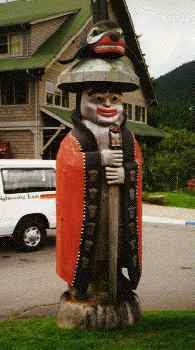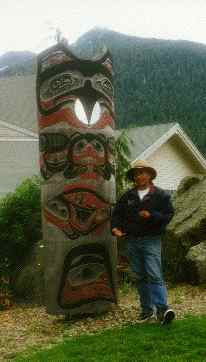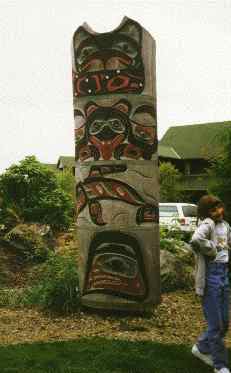From SOCIETY OF INTERNATIONAL FRIENDSHIP NEWSLETTER 38, Fall 1994
We do not know whether the colossal monster which occupies the
foreground is an idol or merely a frightful record of the destructive
nature of death...In a casket whihc lay beneath its claws or hands
was a bowl-shaped basket, a European hat, an otter skin and a piece
of board. The height of the monster was no less than ten and a half
feet high.
--Don Alexandro Malaspina, Italian explorer, describing a totem
pole bear in the late 1700s
 Until recently, all I really knew about totem poles was
that they were made by American Indians, and that somehow they "told
a story". I had a vague idea that they were made in the northwestern
U.S. But I had no clear image of the people who made them, or how
they might differ from the "Indians" (now usually called
"native Americans") seen in cowboy movies.
Until recently, all I really knew about totem poles was
that they were made by American Indians, and that somehow they "told
a story". I had a vague idea that they were made in the northwestern
U.S. But I had no clear image of the people who made them, or how
they might differ from the "Indians" (now usually called
"native Americans") seen in cowboy movies.
In fact, virtually all totem pole carving took place not in the U.S.,
but along the western coast of Canada. The people who made totem poles
lived quite differently from the people who wore feather headdresses
and lived in buffalo-skin "tepees".
It may also come as a surprise to many people that totem pole carving
is not an ancient practice; the height of this art was not reached
until the nineteenth century, after the indigenous people of the north
Pacific coast met European traders. From the traders they obtained
metal carving tools, which made carving much easier than previous
tools, made from stone, wood, deer antlers, and beaver teeth.
There were several groupings of tribes, described by one writer as
nations. These include the Tlingit, the Tsimshian, the Kwakiutl, the
Bella Coola, the Coastal Salish, and the Haida. The Haida, of the
Queen Charlotte Islands, led the others in wood carving and other
skills. They became a prominent, wealthy tribe in the late 1700s,
but, by the 1870s the Haida were on the way out. Thousands had died,
having little immunity to diseases introduced to the area by European
traders.
The Haida are noted for many reasons. As early as the 1850s, they
were capable of carving dugout canoes which could make a 600-mile
(960km) round trip. They built huge, sturdy wooden houses. They carved
large, beautiful, intricate totem poles; they are thought to have
been the first to make them.
The word "totem" refers to an object, animal, etc. which
is regarded as a symbol of a certain group's identity, or perhaps
an item of worship. Totems sometimes appear in "totem poles",
but such poles do not serve as totems. Therefore, "totem pole"
is not really an accurate name for these carved cedar logs.
Various totem pole researchers have tried to count the number of
types or functions of totem poles, and have come up with different
numbers. Edward Malin identifies five:
Memorial Poles
The oldest type of pole, memorial poles were usually less than 30
feet high. They were displayed in memory of tribal leaders who had
died. Nineteenth century photos show that memorial poles were uncarved
except for a single figure on top, often a bird or human. These figures
represented the identity of the leader, portraying either a symbol
of his background (historical or mythical), or the leader himself.
Although the early memorial poles were simpler than the other types
of poles that developed later, they were probably painted.
Interior House Posts
These were support beams in houses which were carved with the crest
or symbol of the family living in that house. Malin writes: "The
posts served as reminders to those who occupied the dwelling of their
ancestral origins and lineage achievements. They were the source of
extraordinary pride and honor. Needless to say, the house posts also
reminded guests and visitors of the backgrounds and achievements of
the host family and as such were viewed not only with the highest
regard but also with envy."
Usually interior poles showed a single figure: an animal, a bird,
or a person. For example, a sea lion, holding up a horizontal house
beam in its mouth, or a human with a house beam resting on his head.
Since they were support beams, they seldom exceeded 20 feet in height,
and tended to be wider than other types of totem poles. House posts
were probably the most widespread type of wood sculpture on the Canadian
Pacific Coast, stretching from Mt. St. Elias, Alaska, to what is now
Bellingham, Washington.
Mortuary Poles
Malin notes that some people who have studied and written about totem
poles have thought mortuary poles to be very similar to memorial poles,
but he identifies some clear differences. They evolved from memorial
and house poles, as the local economy flourished due to trade with
fur companies, and those tribespeople who were profiting commissioned
more ornate and complex poles in order to show off their wealth. Perhaps
the most important difference between the two types is that, while
memorial poles functioned simply as a memorial, a mortuary pole was
used as the resting place of the dead person being memorialized, or
a repository for his ashes. The body was placed in a cavity at the
top of the pole and the hole covered by boards, making the top of
the pole wider than the base. Sometimes the face of an animal or bird
appeared on these boards.
The pole shown on page one is a Haida mortuary pole. An eagle is
perched on top of the pole. The boards covering the cavity in the
pole are decorated with the face of a hawk or thunderbird. Below the
cavity are a whale and a beaver. A common feature of Haida poles is
the extra faces put into empty spaces in the design, such as the top
of the beaver's head. Notice how the small figures crouched body appears
inside the beaver's ear. While this may seem unrealistic or illogical,
it was a common stylistic feature of totem poles.
Heraldic or Free-Standing Poles
This larger type of pole developed a little later, becoming most
developed in the mid-19th century. They are called "Free-standing"
because they were placed relatively far away from houses. These are
the so-called "story-telling poles" which tell about the
mythology and history of the owner. Malin writes:
It is the heraldic pole that provides the basis for publicly
displaying the ownership of important stories that deal with the
respected ancestors. They are the poles that herald supernatural
experiences associated with the bird and animal kingdoms, with
mixed marriages between ancestors and animals, superhuman achievements
of power, and the acquisition of symbols of wealth which provide
the basis for the descendants' notoriety or status.
It is important to note that the stories in the poles cannot really
be "read"; the figures on the poles were simply characters
in stories which the owners of the poles were familiar with. Also,
the arrangement of the characters is not necessarily important. As
a child, I believed that the story could be "read" from
the top of the pole to the bottom, which is the case, according to
Holder. Also, it has nothing to do with rank, in spite of the common
expression in English, "He is at the top (or bottom) of the totem
pole."
House Frontal Poles
 The main difference between House Frontal Poles
and Heraldic Poles is that House Frontal Poles were placed up against
houses, or else were in fact part of the house. Sometimes the entryway
to a house was a hole in the bottom of the pole. Malin shows one example
where one entered the house through a hole in the belly of a carved
grizzly bear. In another case, the bottom figure on the pole was a
raven with a large beak, which opened to let people into the house
behind it.
The main difference between House Frontal Poles
and Heraldic Poles is that House Frontal Poles were placed up against
houses, or else were in fact part of the house. Sometimes the entryway
to a house was a hole in the bottom of the pole. Malin shows one example
where one entered the house through a hole in the belly of a carved
grizzly bear. In another case, the bottom figure on the pole was a
raven with a large beak, which opened to let people into the house
behind it.
In addition to these types of poles, carvings similar to small totem
poles were used a grave markers, after the Christian practice of burying
the dead was introduced, and carvings of a single human figure welcomed
guests to gatherings. Glenn Holder also points out that some poles
were used to ridicule those who let debts go unpaid, by carving that
person's image upside down on a pole. The subjects of these poles
were often white explorers and colonists.
Animals are very prominent on totem poles. The tribes who produced
these poles saw animals as their equals, not inferior to humans. Often
they believed that their family lineage included animals. Naturally,
these animals were native to the Canadian Pacific coast, including
eagles, whales, grizzly bears, wolves, frogs, ravens, beavers, octopus,
mosquitos, salmon, otters, and seals.
However, some of the animals were mythical. Grizzlies, wolves, and
eagles were believed to have counterparts who lived in the sea. Some
figures are combinations of humans and animals, such as a raven with
human feet and hands. The sun, the moon, and various kinds of spirits
are among the other figures appearing on totem poles. Even inanimate
objects, such as an island, have been known to appear on poles.
Many of the stories associated with totem poles are now unknown;
we can only guess at the meaning of the figures on the poles. However,
Malin was able to learn some of the stories, which he briefly recounts.
The pole on page two, a southern Tlingit pole from Tongass village,
"represents Bear Mother, a Tlingit woman who was carried away
by a grizzly bear who became her husband. The two smaller figures
are her children, the result of this supernatural union."
Sources
Holder, Glenn Talking Totem Poles, 1973, Dodd, Mead
& Company, New York.
Malin, Edward Totem Poles of the Pacific Northwest Coast,
1986, Timber Press, Portland, Oregon




 This page last updated
November 4, 2002
. E-mail Tim
This page last updated
November 4, 2002
. E-mail Tim